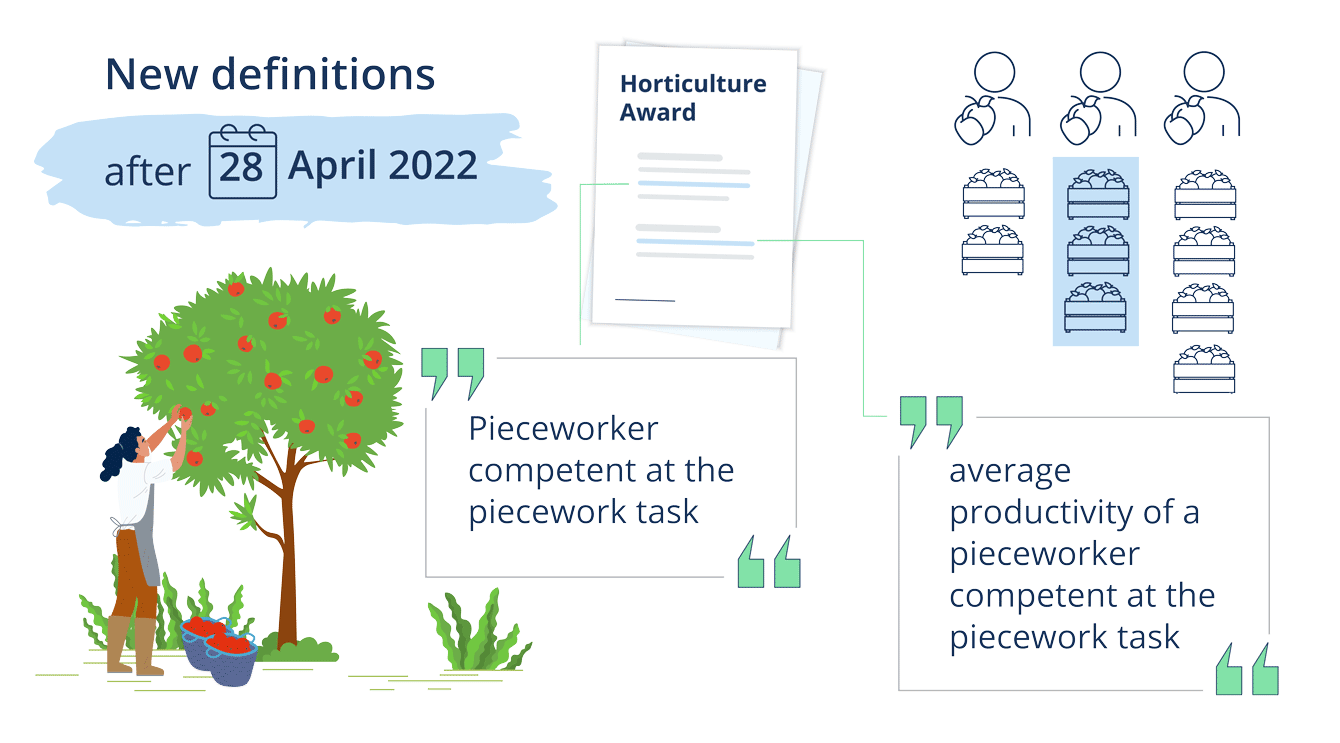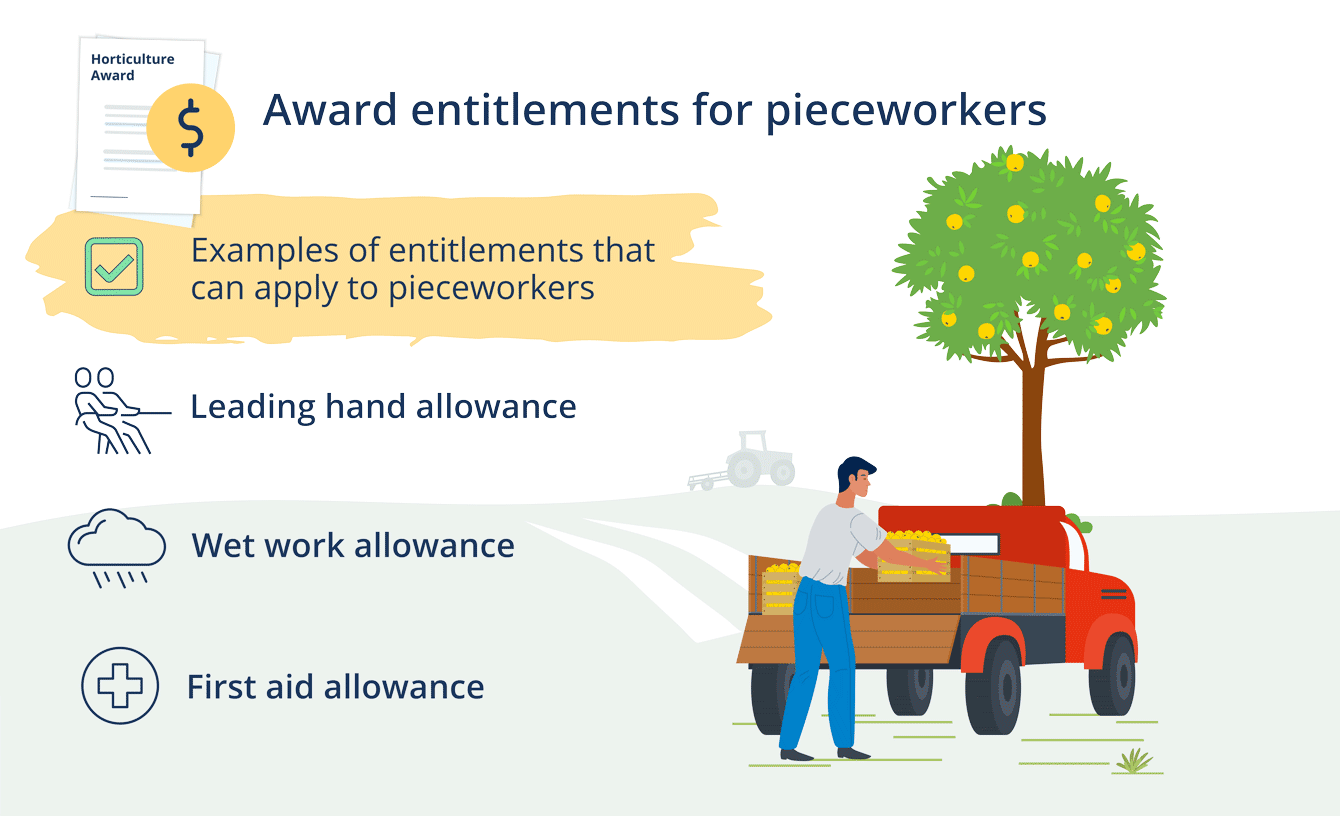How to use piece rates
Understand how piece rates work in the horticulture industry. A piece rate is where an employee gets paid by the piece. It's based on the amount the employee has picked, packed, pruned or made.
Covered by the Wine Award? Go to How to use piece rates – Wine Award.
On this page:
- Piece rates
- Minimum wage guarantee for pieceworkers
- Pieceworker competency and productivity
- Reconciling the piece rates and piecework records
- Other award entitlements for pieceworkers
See also:
Piece rates
Under the Horticulture Award, full-time, part-time and casual employees can be paid a piece rate.
Employees paid a piece rate are called pieceworkers.
If a pieceworker does any work in addition to the task for which they are being paid a piece rate, they have to be paid for that work at the relevant award hourly rate.
Employers have to set a piece rate at an amount so that a pieceworker, working at the ‘average productivity of a pieceworker competent at the piecework task’, will earn at least 15% more per hour than the minimum hourly rate for the pieceworker’s classification level. For casuals, the minimum hourly rate includes the casual loading, so that the 15% calculation is done on top of the casual loading.
There is no difference in how pieceworkers who are or are not yet competent at the task need to be paid. This means that pieceworkers who are not yet competent at the piecework task (that is, with less than 76 hours experience) need to be paid the same piece rate as someone who is competent. They also can’t be paid less or a ‘training’ or ‘introductory’ rate.
Employers can use our free Piecework arrangements employer checklist (DOCX) (PDF) to help ensure they’re meeting the rules for piece rates.
Looking for historical information? Access our historical guidance on piecework rates under the Horticulture Award in our Library article Piecework in the Horticulture Award prior to 28 April 2022.
Minimum wage guarantee for pieceworkers
Pieceworkers covered by the Horticulture Award have a minimum wage guarantee.
The minimum wage guarantee means that for each day a pieceworker works, they have to be paid an amount that is at least their hourly rate multiplied by the number of hours worked that day. The pieceworker’s hourly rate is the minimum hourly rate for their classification level. For casual employees this includes the 25% casual loading.
If the pieceworker would earn more than that minimum amount for the day based on the piece work rate and their productivity, they have to be paid the higher amount.
Below is an example of the minimum wage guarantee:
Example: Minimum wage guarantee and piece rates
Carlos is a casual adult pieceworker who works in an orchard as a level 1 employee, picking apples. He gets paid a piece rate based on the number of bins he fills each day.
Carlos is going to work for 7.6 hours on Tuesday. He wants to know what his minimum pay is for the day. His piecework record says that his minimum rate of pay is $30.35 per hour. (A piecework record is a written record covering piecework arrangements that is signed by the employer.) Because pieceworkers have a minimum wage guarantee, this means that Carlos will earn at least $230.66 ($30.35 x 7.6 hours = $230.66) on Tuesday.
If Carlos fills enough bins so that, based on his piece rate, he will earn more than $230.66 for the day, he gets that higher amount.
Employers can use our templates to record an employee’s hours of work and piece rate and complete piecework reconciliations:
Bonuses and incentives
Some employers want to pay more than the minimum wage guarantee and piece rate rules minimum requirements in the Horticulture Award by paying their employees bonuses or incentives. Employers should consider getting independent legal advice to make sure that the arrangements comply with all of the award obligations.
Pieceworker competency and productivity

Image showing that after 28 April 2022 the Horticulture Award has new definitions about worker output and productivity. This includes a definition of pieceworker competent at the piecework task. Employers should familiarise themselves with these definitions.
There are requirements for working out the ‘average productivity of a pieceworker competent at the piecework task’.
Pieceworker competent at the piecework task
A ‘pieceworker competent at the piecework task’ means a pieceworker who has at least 76 hours’ experience performing the task. Examples of a task include picking fruit, such as apples or strawberries.
Employees can use experience from previous employment to demonstrate that they are a pieceworker competent at the piecework task. They could do this by providing a copy of their piecework employee record from a previous employer, which shows:
- piecework task
- hours worked
- piece rates paid to an employee
Example: How to find a ‘pieceworker competent at the piecework task’
Casey has a pear farm. Casey has 5 employees who are paid piece rates of $8 per carton for picking pears by hand.
Because of changes to the Horticulture Award, Casey needs to review his piece rates for his workers. Casey first needs to determine who is a ‘pieceworker competent at the piecework task’.
4 of his employees each have over 76 hours’ experience picking pears, so they are considered competent at the piecework task.
Average productivity of a pieceworker competent at the piecework task
Employers can work out the ‘average productivity of a pieceworker competent at the piecework task’ by:
- dividing the total output of the pieceworkers competent at the piecework task over a period
- by the total of hours worked on the piecework task by the pieceworkers competent at the piecework task over that same period (where output is measured in the same unit used to specify the piece rate – for example, a punnet, bucket or kilogram).
The most appropriate period to use for working out the average productivity will depend on the circumstances at the farm. For example, a calculation of the average productivity made over a certain period may not be appropriate at a future time if the circumstances at the farm have changed, such as due to changes in conditions like crop density and extreme weather.
Example: Working out the average productivity of a pieceworker
Following on from the previous example, Casey needs to work out the ‘average productivity of a pieceworker competent at the piecework task’ by:
- dividing the total output of his 4 competent pieceworkers over a period (for example, 450 cartons packed by the 4 workers in the previous 2 weeks)
- by the total hours worked by these pieceworkers picking pears over that same period (for example, the 200 hours worked by the 4 workers in that 2 weeks).
Casey calculates that the ‘average productivity of a pieceworker competent at the piecework task’ is 2.25 cartons per hour (450 cartons divided by 200 hours).
Adjusting the piece rate
Employers may need to look at adjusting the piece rate so that employees will be able to earn 15% above the minimum classification level, if they meet the required productivity level.
Example: Adjusting the piece rate so that employees, working at the required productivity level, can earn 15% above the minimum classification level
Continuing with the previous examples, Casey then needs to set the piece rate at a level which allows for a pieceworker achieving the ‘average productivity of a pieceworker competent at the pieceworker task’ (that is, who fills 2.25 cartons per hour) to earn at least 15% above the minimum hourly rate for the pieceworker’s classification level (including the 25% casual loading for casual employees).
Casey knows that his pieceworkers are all level 1 part-time or full-time employees under the Horticulture Award, and therefore have an hourly rate of $24.28. The current piece rate of $8 per carton would only allow pieceworkers filling 2.25 cartons per hour to earn $18 per hour ($8 x 2.25 carton).
Casey’s piece rate for his full-time and part-time adult level 1 pieceworkers needs to be adjusted to allow a pieceworker filling 2.25 cartons per hour to earn at least $27.92 per hour ($24.28 plus 15%). He calculates that the new piece rate needs to be $12.41 per carton ($27.92 divided by 2.25).
Casey gives his 5 full-time and part-time adult level 1 pieceworkers a new piecework record with the new piece rate.
No competent pieceworkers
If there are no ‘pieceworkers competent at the piecework task’, employers can estimate the average productivity by using:
- information about the productivity of employees from previous years
- productivity of employees who have worked for other employers and have provided their employee piecework records
- any guidance provided by industry bodies on setting compliant piece rates for particular piece work, or
- an employer’s best estimate based on their knowledge of their business and the current climate and crop conditions.
If, as the pieceworkers become competent at the piecework task, the piece rate does not allow them to earn 15% above their hourly rate when working at that average productivity, the piece rate should be reviewed. Remember piece rates are also underpinned by the minimum wage guarantee.
Reconciling the piece rates and piecework records
Daily reconciliation of wages
Employers need to do a reconciliation of each day a pieceworker worked. This is to make sure that they are paid at least the minimum wage guarantee every day that they work.
If the pieceworker would earn more than the minimum amount for the day based on the piece work rate and their productivity levels, they must be paid the higher amount.
Importantly, piece rate amounts earned above the minimum wage guarantee on one day cannot be offset against amounts below it on another day.
You can use our Piecework record template (DOCX) (PDF) for this.
Reviewing piece rates
The Horticulture Award doesn’t say how often piece rates should be reviewed.
Employers should review piece rates to help ensure that pieceworkers working at the average productivity of competent employees are able to earn at least 15% more than their hourly rate. This could be affected by various things including:
- changes to work, weather or crop conditions
- any increase to the relevant hourly rate as a result of the annual wage review decision each year.
Remember that before a new piece rate can take effect, employers must give the affected pieceworkers a new piecework record setting out the new rate.
Piecework records
Employers have obligations to keep individual records for each pieceworker. These are known as piecework records. Employers also need to keep records of the hours pieceworkers have worked and the piece rates that applied to those hours. Learn more about these obligations at Piecework records.
Employers can use our:
- Piecework record template (DOCX) (PDF) to easily create a piecework record that meets the Award requirements
- Piecework timesheet template (DOCX) (PDF) to record an employee’s hours of work and piece rate.
Pieceworkers can track their output and hours of work using our free Record My Hours app.
Other award entitlements for pieceworkers

Image showing the entitlements or allowances that pieceworkers usually do get. Check the Horticulture Award to see all the allowances and entitlements that do and don’t apply to pieceworkers.
The following award entitlements can apply to pieceworkers:
- leading hand allowance
- wet work allowance
- first aid allowance.
See a full list of allowances in the Horticulture Award.
Resources
WORKER RESOURCES
Piecework rules have changed information sheet (DOCX) (PDF) (For translated information sheets, see Migrant workers)
